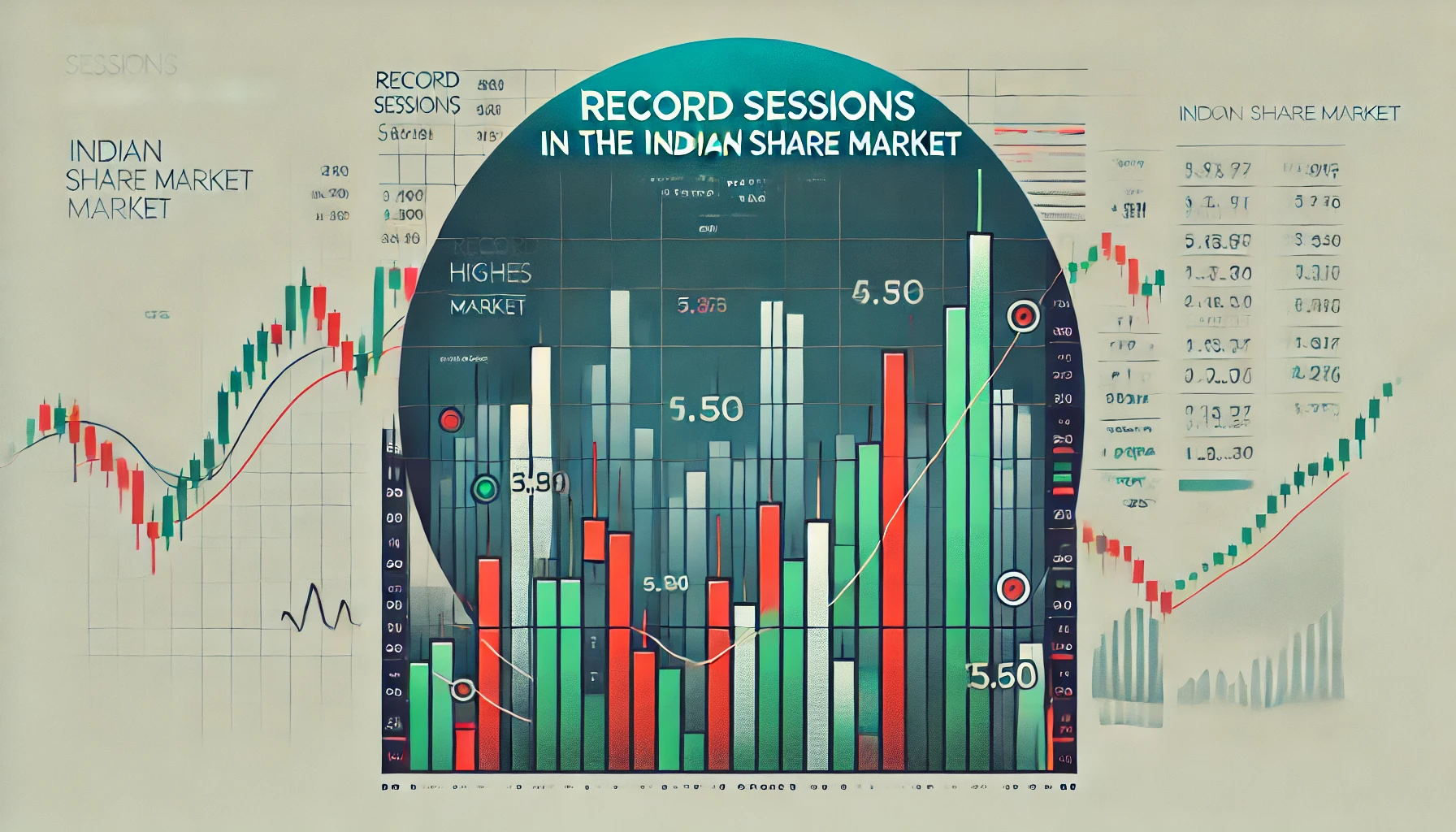The Indian share market is one of the fastest-growing financial markets in the world, with countless opportunities for investors and traders. To successfully navigate this dynamic market, traders rely on various technical indicators. Among the most valuable tools is the Momentum Indicator, which helps traders evaluate the strength and direction of price movements.
This blog will cover how the Momentum Indicator works, its applications in the Indian share market, historical data, and actionable strategies for traders.
What is the Momentum Indicator?
The Momentum Indicator measures the speed of price movement by comparing the current price to the price of a previous period. Unlike trend-following indicators that track price direction, the Momentum Indicator focuses on how fast the price is moving, helping traders identify overbought or oversold conditions.
The basic formula for calculating the momentum of a stock is:Momentum=Current Price−Price from X Periods Ago\text{Momentum} = \text{Current Price} – \text{Price from X Periods Ago}Momentum=Current Price−Price from X Periods Ago
The Momentum Indicator is typically used in two ways:
- Momentum Line Crossing Zero: A positive value indicates upward momentum, while a negative value suggests downward momentum.
- Momentum Peaks and Troughs: High momentum may signal overbought conditions, while low momentum could point to oversold conditions.
How the Momentum Indicator Works in the Indian Share Market
In the Indian share market, the Momentum Indicator is often used in conjunction with other indicators like Relative Strength Index (RSI) or Moving Averages to confirm signals. Let’s break down the key applications:
1. Identifying Overbought and Oversold Levels
When the momentum value is high, it indicates that the market is likely in an overbought state, meaning prices have risen too fast. Conversely, when momentum is low, it suggests oversold conditions, implying that prices have dropped sharply and may soon rebound.
| Date | Price (₹) | Momentum |
|---|---|---|
| 01-Jan-2023 | 1,500 | 150 |
| 15-Jan-2023 | 1,550 | 50 |
| 01-Feb-2023 | 1,600 | 100 |
| 15-Feb-2023 | 1,450 | -150 |
| 01-Mar-2023 | 1,500 | 50 |
2. Divergence Between Momentum and Price
A divergence occurs when the price of a stock moves in one direction, but the Momentum Indicator moves in the opposite direction. This discrepancy often signals a potential reversal in the market trend. For example, if the price is making new highs, but the Momentum Indicator is declining, it may suggest that the upward trend is losing strength.
Historical Data: Momentum Indicator in the Indian Share Market
To illustrate the effectiveness of the Momentum Indicator, let’s look at some historical data from prominent Indian stocks such as Reliance Industries, HDFC Bank, and the Nifty 50 index.
Example: Momentum Analysis of Reliance Industries
| Date | Price (₹) | Momentum (14 days) |
|---|---|---|
| 01-Jan-2022 | 2,100 | 200 |
| 01-Feb-2022 | 2,200 | 100 |
| 01-Mar-2022 | 2,000 | -200 |
| 01-Apr-2022 | 2,150 | 150 |
From the table, we can observe the momentum shifts that occurred in early 2022. Reliance Industries showed strong upward momentum in January, but by March, a sharp drop in price resulted in negative momentum. Traders using the Momentum Indicator could have taken advantage of the bearish trend reversal.
Key Strategies for Using the Momentum Indicator
1. Zero-Line Cross Strategy
A simple but effective strategy is the Zero-Line Cross, which involves entering trades when the Momentum Indicator crosses above or below the zero line. A cross above the zero line signals a buy, while a cross below indicates a sell.
For instance, if you’re analyzing a stock like HDFC Bank, and the momentum moves from negative to positive, it can serve as an entry point for a long trade. Conversely, if momentum turns negative, it can be an early signal to exit or short the stock.
2. Momentum Divergence Strategy
Another popular strategy is to look for divergence between price action and the Momentum Indicator. Divergence occurs when the stock price moves in the opposite direction of the momentum. This often signals a potential reversal.
For example, if the Nifty 50 index is making higher highs, but the momentum is making lower highs, it could indicate that the bullish trend is weakening, and a reversal may be on the horizon.
3. Combining Momentum with Other Indicators
To enhance the effectiveness of the Momentum Indicator, it’s often combined with other technical indicators, such as the RSI or Moving Averages.
- Momentum and RSI: While the Momentum Indicator measures the speed of price movements, the RSI identifies overbought or oversold conditions. By using both indicators together, traders can confirm whether a stock is poised for a reversal.
- Momentum and Moving Averages: The Moving Average helps identify the direction of the trend, while the Momentum Indicator measures its strength. If the price is above the moving average and momentum is increasing, it suggests a strong upward trend.
Advantages of the Momentum Indicator
1. Easy to Interpret
The Momentum Indicator is straightforward, making it easy for both novice and experienced traders to incorporate into their trading strategies.
2. Helps Identify Trend Reversals
By detecting shifts in price momentum, traders can spot potential reversals in the market, giving them an edge in timing their trades.
3. Effective in Volatile Markets
The Indian share market can be highly volatile, and the Momentum Indicator shines in these conditions by providing quick insights into the strength of price movements.
Limitations of the Momentum Indicator
1. Does Not Predict Direction
While the Momentum Indicator measures speed, it does not predict the direction of the market. Therefore, it’s best used in conjunction with other indicators.
2. May Produce False Signals
In ranging or sideways markets, the Momentum Indicator may produce false signals, leading traders to enter trades prematurely.
Historical Application: Momentum Indicator During Market Events
One of the most interesting applications of the Momentum Indicator in the Indian share market is its performance during major market events. Let’s examine how the Momentum Indicator worked during the 2020 COVID-19 pandemic.
Nifty 50 Index During COVID-19
| Date | Nifty 50 Price (₹) | Momentum (14 days) |
|---|---|---|
| 01-Mar-2020 | 11,500 | -500 |
| 01-Apr-2020 | 9,200 | -2,300 |
| 01-May-2020 | 10,000 | 800 |
| 01-Jun-2020 | 10,500 | 500 |
During the market crash in March 2020, the Momentum Indicator accurately reflected the sharp decline in the Nifty 50 index. Traders who monitored momentum could have identified the bearish trend early on. As the market began to recover in May, the Momentum Indicator returned to positive territory, signaling renewed strength.
Conclusion: Harnessing the Power of the Momentum Indicator
The Momentum Indicator is a powerful tool for traders in the Indian share market. By measuring the speed of price movements, it provides valuable insights into the market’s strength and potential reversals. However, like all technical indicators, it’s most effective when used in conjunction with other indicators and market analysis tools.
Whether you’re a novice trader or an experienced investor, mastering the Momentum Indicator can improve your trading performance and help you navigate the volatility of the Indian share market. With the right strategy and approach, you can use momentum to your advantage and make more informed trading decisions.

What is the TRIN stock market indicator?
The TRIN (Trading Index), also referred to as the Arms Index, is a technical analysis …

Record Sessions
The Indian share market is a dynamic and volatile space where major highs and lows …

3 Line Strike
Candlestick patterns are a vital tool for traders in the stock market, offering insights into …

3 White Soldiers and 3 Black Crows
Candlestick patterns are a key element of technical analysis in stock trading, offering clear signals …

Gapping Doji
Candlestick patterns are a critical part of technical analysis in the stock market, providing traders …

3 Windows
Candlestick patterns are a vital part of technical analysis, offering traders and investors insights into …

2 Gapping Candles
In the fast-paced world of the Indian stock market, technical analysis plays a crucial role …

3 Inside Down and Up
Candlestick patterns are powerful tools in the world of technical analysis, offering traders insight into …

Bullish and Bearish Belt Hold
Technical analysis is an essential part of trading in the Indian share market. Candlestick patterns, …

Piercing and Dark Cloud Cover
In the ever-evolving Indian stock market, candlestick patterns are crucial for traders aiming to predict …

Double Doji
Candlestick patterns have long been a favored tool for technical traders to forecast market movements. …

Rising and Falling Windows
In the world of technical analysis, candlestick patterns are vital tools for traders to anticipate …

Tweezer Top and Bottom
In the fast-paced world of the Indian share market, traders use technical analysis tools to …

Morning Star and Evening Star
In the Indian share market, technical analysis is a valuable tool for traders aiming to …

Hammer and Hanging Man
The Indian stock market offers a wealth of opportunities for traders who understand technical analysis. …

Shooting Star and Inverted Hammer
The Indian stock market, with its dynamic nature, presents various opportunities for traders and investors. …

Last Engulfing
The Indian share market is filled with patterns that can help traders make informed decisions. …

Harami
In the world of stock market analysis, candlestick patterns offer valuable insights into price movements. …

Engulfing
The Indian share market is known for its volatility, and traders often rely on technical …

Marubozu
Candlestick patterns are powerful tools used by traders in the Indian share market to analyze …

Spinning Top
The Indian share market, like any other, experiences constant fluctuations due to a multitude of …

Doji
The Indian share market is dynamic, with investors using various tools to gauge stock performance. …

Double Top
In the world of technical analysis, chart patterns are valuable tools that help traders spot …

Tweezer
In the Indian share market, where volatility and price fluctuations are part of daily trading, …

Harami
In the world of technical analysis, candlestick patterns are powerful tools that help traders make …

Heiken-Ashi
Navigating the Indian share market can be challenging due to the inherent volatility and market …

Ichimoku
In the world of technical analysis, few indicators offer the comprehensive insights that the Ichimoku …

Value Charts
In the ever-changing landscape of the Indian share market, traders and investors need tools that …

Money Flow Index
In the Indian share market, identifying trends, understanding momentum, and assessing volume are critical components …

Aroon
In the fast-paced world of the Indian share market, identifying market trends and spotting reversals …

Gator Indicator
In the Indian share market, success is largely dependent on identifying the right trends and …



















